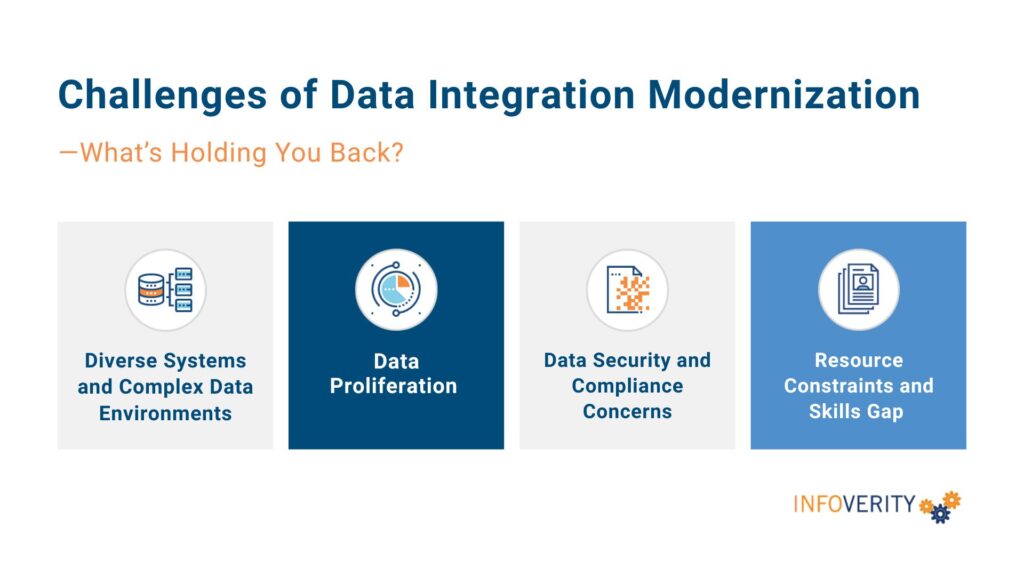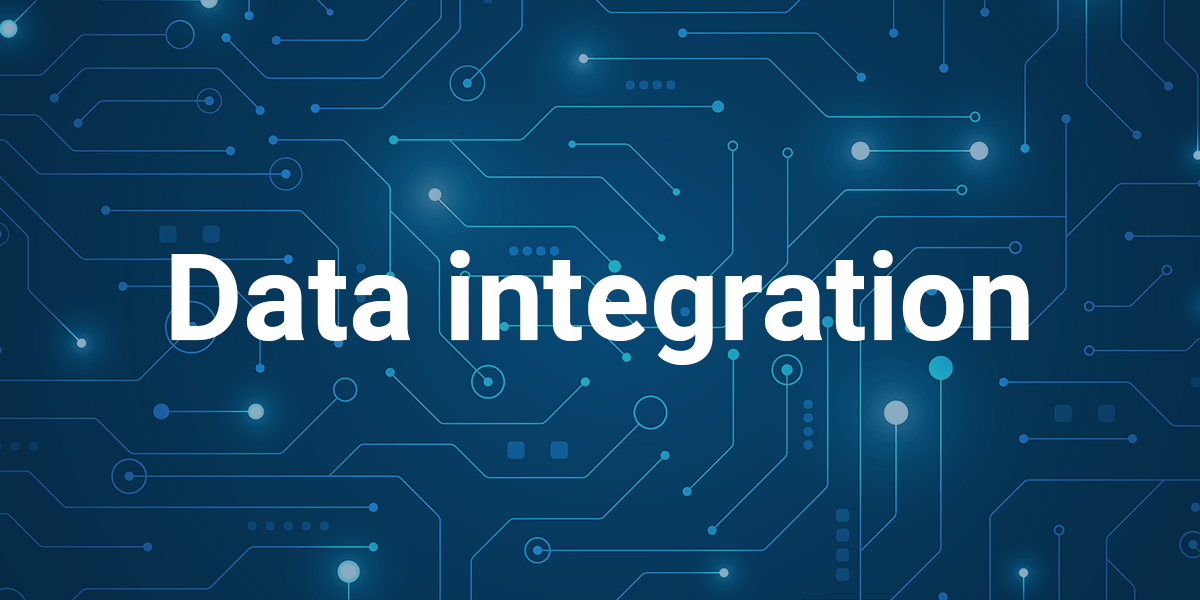Enterprise data is often stored in three places: on-premises, the cloud, and third-party servers. There’s a lot of information to manage, which explains why companies are only able to utilize 57% of their captured data. This is where modern data integration steps in.
By minimizing latency, adapting seamlessly to cloud infrastructure, and incorporating machine learning and artificial intelligence, modern data integration has become indispensable for tech leaders seeking to boost competitiveness and facilitate agile decision-making.
Explore this blog post to learn more about the importance of data integration, its advantages, and the typical challenges businesses face when adopting a modern approach.
Modern Data Integration: Table of Contents
What is Data Integration
Data integration brings together operational data from various systems and applications to derive insights for streamlining business workflows. The process involves gathering data, consolidating it, standardizing it, and transferring it into a target repository.
It significantly impacts the success of new initiatives. Fragmented data sources, inconsistent data formats, and congested data flows can contribute to inefficiency and performance bottlenecks. In fact, 40% of projects reported failure due to difficulties merging and analyzing different data sets alone.
Having a robust data infrastructure is the starting point for becoming a data-led organization, a status modern companies strive for. While using this new bird’s eye perspective, companies can enhance decision-making, reduce manual work, and provide better customer service.
Benefits of Data Integration Modernization
Data integration allows organizations to maximize their data assets’ value. Here are some tangible advantages enterprises can realize:
1. Improved Data Velocity for Agile Decision-Making
Organizations collect vast amounts of data, but only 23% of insights are automatically derived. Indeed, this isn’t enough. With the current fast-paced business environment, comprehensive real-time insights are key to timely business decisions.
Modernizing processes allows organizations to effectively access and deliver data for analytics as needed. Thus, and with the latest information available at their fingertips, organizations can recognize and respond to market trends and customer feedback, develop new ideas, and identify threats as early as possible.
2. Scalability That Supports Business Growth
Many businesses are struggling to manage exponential data growth. Research shows that 57% of business and IT leaders think data volume is growing faster than their organization can handle.
Growing businesses are especially vulnerable to this. Operational expansion often means new data sources. Integrating this deluge of data efficiently is possible with a modern strategy. Such a strategy is necessary for mitigating performance issues.
Data integration doesn’t just support scalability. It also fuels it. Organizations can use their unified data system to discover untapped revenue sources, such as new products, services, or markets.
3. Cost Efficiency and Reduced Maintenance Overheads
Data integration streamlines various tasks, resulting in lower maintenance and personnel expenses. Reporting and analytics stand out as prime examples of this enhanced efficiency in action.
Statistics
Tech teams typically spend 30% of their time rectifying erroneous data. With data integration contributing to superior data quality, the necessity for data collection and validation diminishes. The unified view of data also slashes decision-making timelines and expedites the transition from insight to action. A manufacturing company could use integrated data to identify delays in raw material deliveries or bottlenecks in distribution channels, for instance. Furthermore, data quality improvements help companies avoid losing an average of $12.9 million to poor data.
Other ways it can cut costs include reducing the need for root cause analysis, data profiling, auditing, and the like, as well as optimizing resource utilization by allowing resources to be adjusted based on demand.
4. Enhanced Customer Experience
On average, a customer journey consists of about 20 to 500+ interactions. These multiple touchpoints are unpredictable and difficult to track.
Integrating customer information allows organizations to align marketing, sales, and product development teams to create more effective campaigns and products, as well as improve customer retention and acquisition. Unified data also help support teams resolve issues/complaints faster.
Looking for data integration guidance?
Infoverity can help your business in every step of the data integration process. To discover more on how we can help you ➡️ Check out our data integration services
Challenges of Data Integration Modernization
Taking on enterprise data integration poses many challenges. Thus, companies are expected to run into the following obstacles when taking on this task on their own.

1. Diverse Systems and Complex Data Environments
72% of companies operate on a hybrid IT infrastructure that combines proprietary, legacy, and cloud-based systems. Additionally, third-party vendors, partners, or public APIs can introduce data format and structure variations.
These varying data formats and sources require advanced and versatile integration tools and solutions. The task often entails working with different APIs and protocols, adding a layer of complexity that many organizations aren’t equipped to handle.
2. Data Proliferation
A data integration solution should be able to handle large datasets efficiently and reliably. If not, businesses must work on dividing data into manageable segments to reduce system load, which still doesn’t offer a long-term solution.
They need to be familiar with the available scalable solutions and choose one that fits their needs. Ideally, a data integration platform should adeptly manage surging data volumes without compromising performance. Moreover, it should exhibit agility as increasing data, system updates, and shifting business strategies demand flexibility in processes.
3. Data Security and Compliance Concerns
As data grows, the issue of security becomes more pressing. Integration modernization efforts need to include a set of measures, such as access control and encryption, to ensure safe data transmission and processing across platforms and teams.
Furthermore, organizations need to think about data protection regulations, establish data governance frameworks, and foster a privacy-conscious culture. All of these require a lot of time and effort, highlighting the need for guidance and expertise in integration modernization.
4. Resource Constraints and Skills Gap
70% of corporate leaders have reported that a critical skills gap exists in their organization, negatively impacting business results.
This, along with restricted resources, is also a key challenge when implementing and managing modern solutions. Addressing it requires either internal training or partnering with external experts.
Data Integration Success Stories
While challenges exist, the right tools and professional guidance can overcome them. Here are stories of how two prominent brands managed to fix muddled data, organize it, and then use it to drive their initiatives.
Yamaha
Yamaha Motorsports set out to harmonize its global data and streamline operations. Following this, it branded the initiative as “One Yamaha,” aiming to merge all data and analytics into one cloud-native platform, eliminating legacy systems.
In just two months, Yamaha integrated Informatica Intelligent Data Management Cloud (IDMC) into its data management process. Some of the immediate benefits included real-time data access, improved scalability, and reduced overhead costs. Yamaha also attributed reduced cancelled orders and improved customer satisfaction to real-time data processing that reduced fulfillment errors.
Through data democratization and increased insights, Yamaha aligned business priorities with its data strategies, driving performance and profits.
Bayer
Bayer Corporation’s agricultural and environmental branch, Bayer Crop Science faced the challenge of managing a sprawling ecosystem of custom point-to-point (P2P) integrations within Salesforce. Therefore, this approach posed several problems, in terms of costs, scalability, management, and data access.
The company aimed to break down the data silos it created and improve agility. Bayer went on to replace its P2P integrations with API-led connectivity to integrate Salesforce with legacy systems. MuleSoft Anypoint Platform made this possible. Bayer also leveraged MuleSoft’s CloudHub platform to remove its need to manage AWS resources. This allowed the company to invest more resources in developing APIs and future-proofing its integration architecture.
Indeed, the results included 200% faster product development, a 70% reduction in process functions, and a 20% decrease in overhead and security governance. Thus, MuleSoft also imparted reusable components, such as connectors and job templates, further adding efficiency and cost savings.
Managing Dynamic Data Environments
Modernized systems should be put into place to handle a company’s increasing data volume and workload. In addition, companies should remain vigilant about necessary system updates, data security challenges, and changes in business needs.
Companies must take a step towards becoming a data-driven organizations. Thus, by investing in the right platform and obtaining expert support, they can ensure the longevity and quality of their data infrastructure. Talk to a professional today.
FAQs – Data integration
What is data integration?
Data integration brings together operational data from various systems and applications to derive insights for streamlining business workflows. The process involves gathering data, consolidating it, standardizing it, and transferring it into a target repository.
What are the benefits of data integration modernization?
Modernizing data integration enhances agile decision-making with real-time insights, supports scalability to manage growing data volumes, reduces costs through streamlined processes and improved data quality, and strengthens customer experiences by aligning teams, optimizing campaigns, and enabling faster issue resolution.
What are the challenges of data integration modernization?
Modernizing data integration comes with significant obstacles, including complex environments with diverse systems and APIs and managing surging data volumes efficiently. Organizations often struggle without proper tools, expertise, or scalable solutions, making it essential to seek guidance and invest in streamlined processes and training or partnerships.
What is a data integration tool?
Varying data formats and sources require advanced and versatile integration tools and solutions. The task often entails working with different APIs and protocols, adding a layer of complexity that many organizations aren’t equipped to handle. While data integration challenges exist, the right tools and professional guidance can overcome them.



